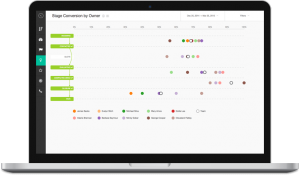— May 4, 2018

How many connections do your company’s employees have on LinkedIn? How many followers does your LinkedIn company page or Twitter feed have? It’s easy to get excited as these numbers build, but does it really matter?
Yes and no.
It matters because more connections and followers can result in an increased number of leads and ultimately boost revenues. However, the sad reality is there’s no guarantee that social media buzz will transform magically into qualified leads.
So how do you transform online followings and social activity into bottom-line results? You need to integrate your social media marketing initiatives into your lead generation process.
That’s easier said than done, so let’s break it down into bite-size chunks.
- Be Social
You may have connections and followers, but are you engaging with them? This is the first step to building relationships and trust. So what should you be doing on each of the social platforms?
- LinkedIn
Once you’ve optimized employee profiles and your company page, start sharing content on your newsfeed. Each time you share information, it’s a chance to remind your connections of your expertise and the company you represent. When you do so, think first about your audience. What do they want to learn about? To serve their needs, curate content from a wide range of sources and mix it with your company’s resource. Even though your business did not create all the content you share, you’ll start to develop a reputation as a thought leader and valued resource.
There are other opportunities to interact, such as when connections have birthdays, change jobs or receive promotions. Congratulate them and say “happy birthday,” just as you would if you were at an in-person networking event.
- Twitter Similarly, on Twitter, engage with your followers by commenting on their tweets and retweeting them. Also, post content — once again, a mix of your own and curated articles. A good rule of thumb is a four to one ratio of curated to company-created content. Within your own content, you can post links to your landing pages, perhaps once a day.
- Facebook The same general principles apply to Facebook as to the other social platforms — engage with people and share a mix of content.
- LinkedIn
Once you’ve optimized employee profiles and your company page, start sharing content on your newsfeed. Each time you share information, it’s a chance to remind your connections of your expertise and the company you represent. When you do so, think first about your audience. What do they want to learn about? To serve their needs, curate content from a wide range of sources and mix it with your company’s resource. Even though your business did not create all the content you share, you’ll start to develop a reputation as a thought leader and valued resource.
- Capture Leads
Your next step is to capture a lead. To do so, you need to attract your target audience to your website by offering them something that’s of value to them — a piece of content that provides helpful insights. That’s why you mix your content with curated content.
You can start small with blog posts. Alone, they will not bring in the leads, but they establish your credibility. You should include a call to action that directs readers to a landing page. It can be at the end of the page or in a sidebar. Offer a free e-book, white paper or webinar in exchange for contact information — email address and first name at minimum. If you’re offering highly sought-after material, such as an industry research report, you’re more likely to be able to capture additional data, such as phone numbers and company names.
- Qualify Leads
The truth is, you don’t just want leads. You want qualified leads. And here’s why social- media leads often get a bad reputation. It’s because in many companies they’re treated differently. Somehow they circumvent the lead qualification process.
Instead, review the data you have collected with the objective of winnowing down the list to those who are worth the time to follow up. Unfortunately, that’s easier said than done. You cannot merely look at the email addresses and discard those that use Gmail or a home address because it’s relatively typical for someone not to use a business address on social media. That means you have to do some digging on LinkedIn and other resources, such as InsideView, to establish whether a lead matches with your customer profile.
Once you have honed down the list, have a business development representative conduct a lead qualification call. The purpose is to determine whether this individual or someone else at their organization has the budget, authority, need and urgency to purchase a solution that resolves their problem.
Once the lead has made it through the initial screening criteria, you may want to forward the lead to an inside sales or technical sales person who can ensure your product is a good fit for the individual’s company and determine next steps.Having gone through this qualification process, you should integrate your social media leads with all the others. Now they can follow your standard lead management process, giving you a structured methodology for transforming social buzz into leads, sales and revenue.
So social media lead qualification starts with engaging the right followers and connections on social platforms. Then you want to attract them to your website and capture leads. The qualification process begins with manual screening and matching leads up as much as possible to secondary information. Then take the leads that make it through that process and call them to make sure they are in the market for your product and have the means to purchase it. Finally, add your social media leads to your standard lead management process.
Digital & Social Articles on Business 2 Community
(4)






